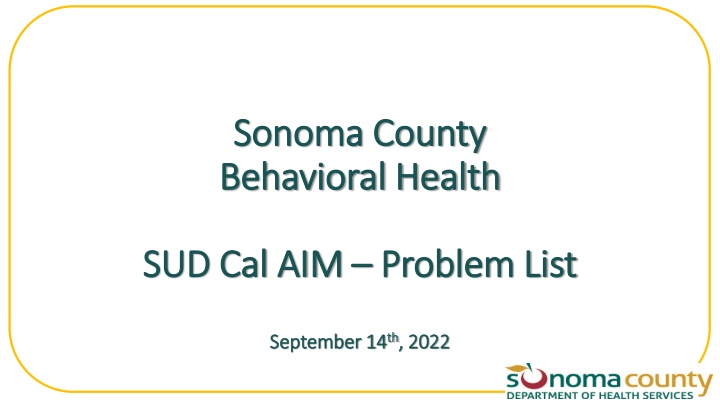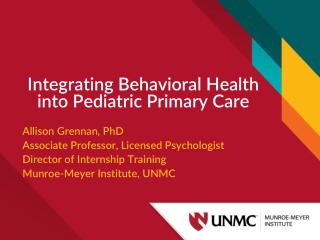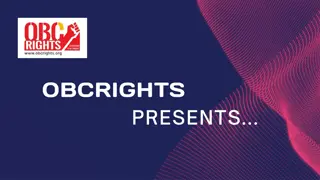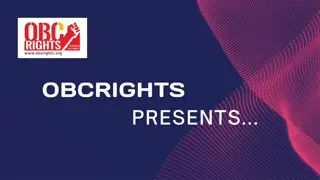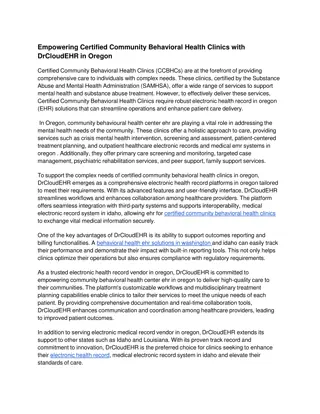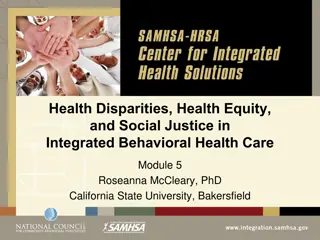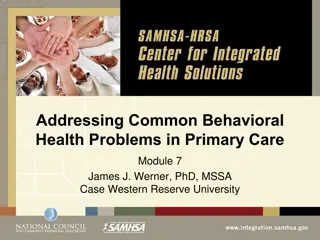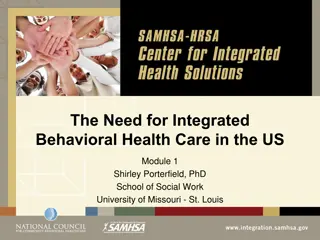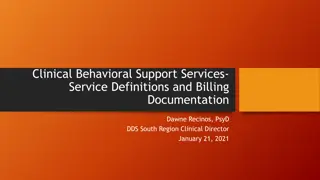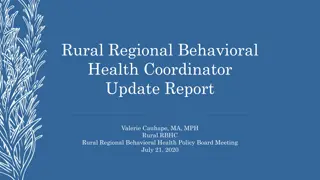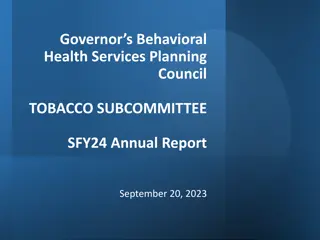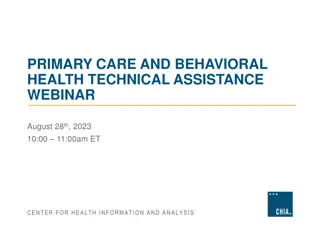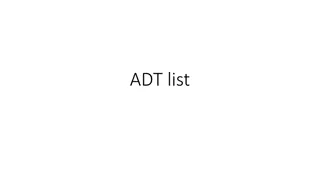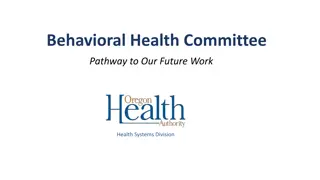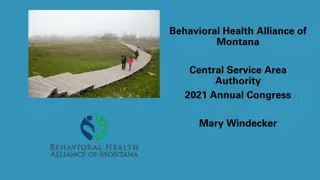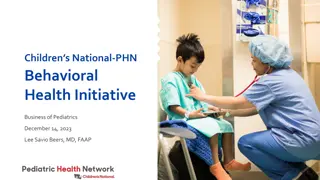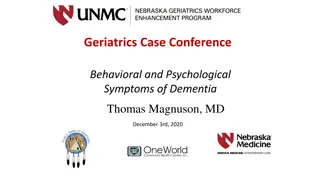Problem List in Behavioral Health
In behavioral health, a problem list includes various symptoms, conditions, diagnoses, and risk factors identified through assessments and evaluations. It helps in tracking necessary interventions and supports medical necessity.
Uploaded on Mar 20, 2025 | 0 Views
Download Presentation

Please find below an Image/Link to download the presentation.
The content on the website is provided AS IS for your information and personal use only. It may not be sold, licensed, or shared on other websites without obtaining consent from the author.If you encounter any issues during the download, it is possible that the publisher has removed the file from their server.
You are allowed to download the files provided on this website for personal or commercial use, subject to the condition that they are used lawfully. All files are the property of their respective owners.
The content on the website is provided AS IS for your information and personal use only. It may not be sold, licensed, or shared on other websites without obtaining consent from the author.
E N D
Presentation Transcript
Sonoma County Sonoma County Behavioral Health Behavioral Health SUD Cal AIM SUD Cal AIM Problem List Problem List September 14 September 14th th, 2022 , 2022
Problem List: What is it? Problem List: What is it? A list of symptoms, conditions, diagnoses, and/or risk factors Identified through assessment, psychiatric diagnostic evaluation, crisis encounters, or other types of service encounters The problem list shall include, but is not limited to, the following: Diagnoses identified by a provider acting within their scope of practice, if any. Diagnosis-specific specifiers from the current DSM shall be included with the diagnosis, when applicable Problems identified by a provider acting within their scope of practice, if any Problems or illnesses identified by the beneficiary and/or significant support person, if any The name and title of the provider that identified, added, or removed the problem, and the date the problem was identified, added, or removed Problem list and progress note requirements shall support medical necessity Can add more elements such as client and counselor initials (CP DAAC Client Engagement) Discussion: What do you think should be added or may be helpful to include on a list?
Problem List: Cal MHSA Example Problem List: Cal MHSA Example
Problem List: Other Examples Problem List: Other Examples Copy of template being used by another county Copy of template being used by Center Point DAAC
Problem List: SWITS Problem List: SWITS DHS is asking that providers keep both a paper and a SWITS problem list The SWITS problem list is very basic and is a miscellaneous notes with selecting problem list note type The content of the note can be edited and updated as the problem list changes
Problem List: SWITS Problem List: SWITS
Problem List: SWITS Problem List: SWITS
Problem List: NTPs Problem List: NTPs Problem List is addressed in BHIN 22-019 NTPs are NOT required to do Problem List Narcotic Treatment Programs (NTP) are required by Federal law to create treatment plans for their beneficiaries. Furthermore, NTP requirements for documentation and program requirements are not changing under this BHIN. NTP program physical exam requirements, timeframes, and documentation requirements are retained. Sonoma County DHS is seeking guidance on ASAM and Telehealth for NTPs and responses are pending. Parts of BHIN 22-019 may still apply.
Problem List: When? / Who? Problem List: When? / Who? How often does the problem list get updated and by whom? Wanted implemented 9/12/22, will be monitoring starting 9/30/22 (there is still time!) The provider(s) responsible for the beneficiary s care shall create and maintain a problem list Updated on an ongoing basis to reflect the current presentation of the client Updated when there is a relevant change to a client s condition by adding or removing from the list A problem identified during a service encounter (e.g., relapse) may be addressed by the service provider (within their scope of practice) during that service encounter, and subsequently added to the problem list The problem does not need to be listed before addressing it Providers shall update the problem list within a reasonable time and in accordance with generally accepted standards of practice
Problem List: Who Gives Input? Problem List: Who Gives Input? Based on previous slide pretty much anyone can have input right? Licensed practitioners of the healing arts acting within scope of practice Peers utilizing appropriate Z codes Beneficiaries and their support persons BUT LPHA Licensed Professional Clinical Counselor (LPCC) still to be determined for signing off on SUD diagnoses. Title 22 is not updated with LPCC and is in conflict with SPA noted below Here is the SPA (state plan amendment) link sincere apologies for not responding to your previous message! https://www.dhcs.ca.gov/Documents/CA-20-0006-A-Approval-Package.pdf See the definition of LPHA on p. 11 of the PDF (labeled in the document as page 6, Supplement 3 to Attachment 3.1-A).
Problem List: Using Your List Problem List: Using Your List While you have 30 (21+ years) to 60 ( < 21 or homeless) to complete the assessment a provisional diagnostic impression and ICD-10 code must be assigned other specified ICD-10 codes (LPHA) unspecified ICD-10 codes (LPHA) encounter for observation for other suspected diseases and conditions ruled out (LPHA) Z codes Z55-Z65 for LPHA and Non LPHA (good for peer providers) Z63.0 Problems in relationship with spouse or partner Z59.0 Homelessness (.01 sheltered, .02 unsheltered) Z56.0 Unemployment, unspecified Update problem list as soon as a full assessment and diagnosis are completed A provisional screening is fine for Level of Care during the assessment window, BUT a full ASAM must be completed during this window and still drives the LOC. Update as soon as reasonably possible when changes to problem list, but a general guideline to fall within would be in alignment with progress notes and the 3 day standard Utilization with Client in real time is the ideal, but not always possible. Examples!
The Brief Questionnaire for The Brief Questionnaire for Initial Placement: Initial Placement: BQuIP BQuIP DHS is reviewing BQuIP to screen for LOC in our system of care UCLA developed and piloted (in Beta version may be some changes) DHCS approved to use for non-clinical staff who have completed BQuIP training Objective is to get LOC recommendation right (matches full ASAM) > 80% Screens for key risk categories: withdrawal, medical, mental, readiness for change, relapse, environment Generates recommendations for critical issues, withdrawal management, additional services, and LOC recommendation Takes about 10 minutes to complete but varies based on client presentation The Brief Questionnaire for Initial Placement (uclaisap.org)
Problem List Wrap Up Problem List Wrap Up Your concerns? Your questions? We will document your questions, concerns and send out a response, in writing, addressing each question Rather than answering here we want to be sure we consult with DHCS and DHS-BHD SUD Section staff, QA and Compliance, as needed. BHQA@sonoma-county.org
County Contacts County Contacts Melissa Struzzo, SUD section manager Office: 707.565.4975 Melissa.Struzzo@sonoma-county.org Chris Marlow, QAPI section manager Cell: 707.490.4160 Christina.Marlow@sonoma-county.org Will Gayowski, SUD QA manger Cell: 707.321.9876 Will.Gayowski@sonoma-county.org Cammie Noah, SUD QA manager Office: 707-565.7472 Cammie.Noah@Sonoma-county.org
